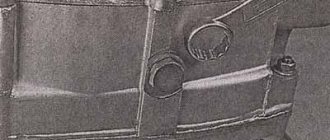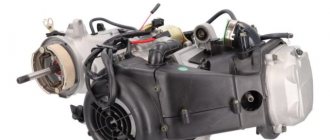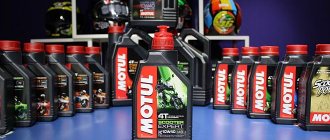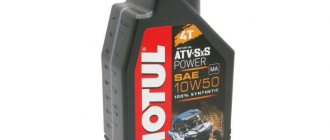Bykov K.P., Shlenchik T.A.
Changing the engine oil
The engine oil is changed after 1,000 km, and then every 2,000 km.
The engine oil is replaced on a hot engine in the following order (Fig. 18): • remove the oil dipstick (Fig. 18.1) and unscrew the nut to drain the oil (Fig. 18.2); • drain the used oil (Fig. 18.3); • after checking the condition of the sealing gasket of the oil drain nut, tighten the nut (tightening torque 2.3 kgcm); • pour approximately 0.7 liters of oil into the crankcase through the hole for the oil dipstick (Fig. 18.4); • reinstall the oil dipstick; • start the engine and let it run for several minutes at idle speed, stop the engine; • check the oil level and, if necessary, bring it up to normal.
Rice. 18. Changing engine oil
How to understand modern oil labeling?
Recently, many brands of motor and transmission oils from various companies have appeared on sale: SHELL, BP, CASTROL, MOTUL, NESTE, MOBIL, TEXACO, ELF, TEDEX, VALVOLINE, TEBOIL, etc. How to make sense of all this abundance and understand the principle of oil selection ? All oils have many indicators indicated in the technical specifications, but we, as buyers, should be interested in only two of them: quality level (will it suit my motorcycle) and viscosity (is it suitable for the upcoming season and in general for this climate). The answer to these questions is contained in the labeling of any commercial grade - the globally accepted indexing system for motor oils.
Viscosity is determined and indicated according to the method of the American Society of Automotive Engineers SAE (SOCIETy OF AUTOMOTIVE ENGINEERS). The letters SAE on the label mean that the subsequent numbers characterize the viscosity of the oil. Only viscosity, and nothing more! The letter W (WINTER - winter) is placed in the designations of winter varieties (SAE 5W, SAE 15W), while summer varieties do not have any letter (SAE 40, SAE 50). In all-season varieties, in the viscosity marking, after the letters SAE, the winter indicator first follows, and then the summer indicator. Between the two designations there is usually a hyphen or fraction sign, and sometimes nothing at all. For example, SAE 15W-40, SAE 10W/40, SAE 15W40. An example of motor oil marking is shown in Fig. 16, and the manufacturer's recommendations regarding the use of motor oils for gasoline engines are given in Table. 4.
Photo report: changing the oil in the engine and gearbox of a scooter
It would seem that it could be easier? I mixed the old oil and filled the new one, but nope. There are people who manage and punish.
Preparation
In order to throw the oil glass away from the engine, everything else. engine
Before changing the oil, it must be thoroughly warmed up. Or what would be better. Start changing the oil immediately after a 5-10 km trip.
The second preparatory step is that we need to prepare a level platform in advance on which the scooter should be installed in the flattest position and prepare a suitable container for waste oil.
The tools you use also play a strong role. Don't skimp. buy a new head with a collar. You only need two parts: 17 and 10. Those who ignore this point. then he pays a lot out of his own pocket.
Or maybe it’s still a car?
The first thing that catches your eye when comparing car oil and motorcycle oil is the price. Motor oil is much more expensive than automobile oil.
According to manufacturers and many vehicle owners, motor oils spoil motorcycle components, and the clutch disappears.
But there is another opinion, according to which some conditionally negative impact actually happens. But this only applies to the clutch. And all the negativity comes down to the fact that modern oils have very strong cleaning properties, which simply lead to clutch slippage. But you can use less modern oil!
How to change the oil on an alpha moped
1. Unscrew the bolt on the bottom of the crankcase 2. Wait for oil
will merge 3. Fill in a new one 4 Rejoice)))
While the oil is draining. go to the right side of the scooter. unscrew the control probe and the oil filter plug located at the very bottom of the engine.
We put a good head on the plug on the plug, turned it and pulled it out of the engine with all its contents.
This is an oil filter. Immediately after twisting it, while the point is yes. throw all this garbage into clean gasoline, have a good chat there, and then blow and dry.
After the oil filter plug has been removed from the engine. To dislodge any remaining engine oil, bleed the engine several times using a kickstarter.
After this we will wait about five minutes. wipe the drainage holes dry, for greater reliability we place sealant on the plugs and screw them into place.
Quality Standards
Motor oils have various specifications indicating their quality: API, JACO and others.
The oil standard is indicated on the canister. After the letters API there is a letter designation of oil quality: from SA to SM. The S scale indicates that the oil belongs to gasoline engines; the quality scale is indicated by letters from A (low quality) to M (high quality). A total of 11 quality classes are provided: A, B, C, D, E, F, G, H, J, L and M. Products with specifications from SA to SE are currently almost never produced and are only suitable for older equipment manufactured in 80s or 90s. Modern mopeds and scooters consume oil of at least SF quality, but it is better if it is SH, SJ or SL.
Scheme for studying the motor oil label.
SH - products for engines manufactured after 1994. SJ - for engines manufactured after 1996. SL – for engines after 2000. SM – for engines after 2006.
API-TA is required for two-stroke moped and lawn mower engines. For large capacity two-stroke engines of low power - API-TB standard. For powerful large-capacity two-stroke engines - the API-TC standard.
The Japanese JASO standard is intended for models of mopeds and motorcycles with a “wet” clutch, that is, a clutch operating in an oil bath. With this design, the power unit and clutch use the same oil. Accordingly, changing the transmission oil on the scooter will occur simultaneously with replacing the engine oil. Therefore, using a high quality, low friction product may cause this clutch to slip. JASO is suitable for motorcycles manufactured before 1994 or copied models of that time. For modern mopeds and scooters, you should choose JASO MA, JASO MA-1 with a high friction coefficient. The JASO MA-2 standard has an even higher coefficient of friction, but is intended for sports mopeds and scooters. JASO MB has a low coefficient of friction and is not suitable for wet clutch vehicles.
For two-stroke engines, the JASO standard has completely different designations. JASO FA - intended for use in developing countries. JASO FB is the minimum quality standard for Japan. JASO FC is a smokeless oil for a wide range of two-stroke engines made in Japan. JASO FD – for two-stroke engines with increased requirements for the quality of motor oils.
The European ACEA oil quality designation standard is often found. Grades ACEA A1 to ACEA A5 are intended for four-stroke gasoline engines (two-stroke engines are not produced in Europe). Moreover, category A2 denotes the lowest quality oil, and A4 - the highest quality. For engines with normal operating characteristics, category A2 is recommended. Category A3 is recommended for use in motors with high performance. Category A4 is used in motorsports. Certain categories A1 (with particularly low viscosity) and A5 (the latest oils) are not suitable for all engines and are used only in cases where this is directly specified by the manufacturer.
Checking the oil level
The oil level is checked as follows: pour the first portion of oil into the engine approximately 600-700 ml, wait a few minutes until the oil spreads evenly onto the crankcase without twisting, insert the dipstick into the neck, pull it out and look at the level.
The oil level should be in the control section.
- If the level is less. add some oil
, wait a couple of minutes and take a measurement. - If the oil level is higher than normal. drain it or better yet. pump it with a syringe with a tube from the neck.
The control section is indicated by red arrows. In my case, the oil level is exactly in the middle of the control section and is indicated by a blue arrow. Ideally, the oil level should be in an area outside the control interface. But this is ideal, but in practice. the average level is quite acceptable and does not affect the reliability and durability of the engine.
Marking and viscosity
Engine wear is affected by the oil viscosity parameter
. The required viscosity depends on the operating temperature of the engine and is usually specified in the operating instructions. The generally accepted standard for designating viscosity according to the American SAE method: 5W40, 5W30, 10W40, 10W50 or simply SAE 40, SAE 50. Moreover, the first number indicates the viscosity of the oil in a cold engine, the second - in one warmed up to operating temperature. The letter W indicates that the oil belongs to winter or all-season varieties. Summer varieties do not have this letter and the first number (SAE 30, SAE 40). The lower the first number, the better the engine starts in cold weather. But if there is no need to ride a moped in winter, there is no point in using liquid oil. In warm weather, high viscosity provides better lubrication of power unit parts, the oil film on rubbing surfaces is not destroyed, and dry friction, overheating and destruction of parts are prevented.
For summer, viscosity 10W40, 10W50, SAE 30, SAE 40, etc. is more suitable. The higher the viscosity of the oil when hot (second number), the better suited the oil is for hot operating conditions. In mid-latitudes, SAE 30 or SAE 40 is quite suitable. In hot countries, SAE 50 and even SAE 60 are used.
Return to contents
Changing the gearbox oil
At the very bottom of the engine on the left side of the road. we are looking for a drain plug and plug. The jam is on the side or top, and the drain is always on the bottom.
We replace the drain plug container, we unscrew both plugs.
We wait about ten minutes until the old oil drains from the gearbox.
Clean the drain hole and plug, apply sealant to the plug and screw it into place.
We take oil. I take a liter container so inexpensive and enough for about 10 replacements. If you change your oil infrequently. Buy a special tube of patented scooter gear oil. This is more than enough for one replacement and without additional headache, punch it with a special spout into the filled hole.
Types of oils
Lubricating fluids are designed to reduce wear of contacting surfaces and reduce energy efforts to overcome friction forces. In addition, the materials form a durable oil film in the contact areas, which helps remove heat from engine parts, seals working components and protects the internal surfaces of the cylinder block from corrosion.
The properties of oils depend on the technical characteristics of the base and the chemical composition of modifying additives that are introduced into liquids to improve their performance parameters. The basic components of oils are divided into several categories:
- synthetic;
- semi-synthetic;
- mineral.
Synthetics
Synthetic motor oils are produced by the synthesis of hydrocarbon organic substances. Polyalphaolefins or ester derivatives are used as base components for the production of technical fluids. Chemical processing and subsequent purification of raw materials make it possible to obtain high performance properties of the mixtures:
- stable viscosity-temperature characteristics;
- low volatility;
- chemical resistance;
- high flash point;
- wide range of inter-service maintenance;
- increased antioxidant and anti-corrosion properties.
Due to their high thermal properties and low oxidizing ability, synthetic oils perform well in air-cooled two-stroke gasoline engines. Their use makes it possible to reduce the smoke of exhaust gases and minimize the formation of soot on the cylinder walls.
Mineral petroleum products
Mineral oils are products of direct distillation of petroleum. The quality of lubricants depends on the method and depth of purification of raw materials. To give the base components the recommended performance properties, modifying additives are introduced into the base of technical fluids. The composition of the package and the amount of chemicals is determined by the conditions of use of motorcycle equipment.
Mineral lubricants are cheaper than synthetics and semi-synthetics, but due to the ability to quickly burn with the formation of carbon deposits, a two-stroke scooter engine must be washed and cleaned frequently. For this reason, the resulting savings are offset by labor costs for frequent maintenance.
Semi-synthetics
Semi-synthetic oils are an intermediate option between the previous types of liquids. The basis of the structure is mineral components, which contain 20–40% synthetics. Synthetic additives ensure easy starting of a cold engine, protect parts from premature wear, and clean the engine well from combustion products. The materials are used to lubricate any type of engine, except for high-performance models operating in extreme conditions. In mopeds with a two-stroke engine, semi-synthetic oils increase engine life and reduce the likelihood of carbon deposits.
Checking the gearbox oil level
We pump the same control into the filler hole. oil exactly until it starts to flow out of it. As soon as the oil starts flowing. Stop pouring and wait a few minutes until the excess flows out and wraps around the plug.
On some scooter models, there is no way through which we can determine the required oil level, and instead there is a boost jumper and drain. In this case, the recommended oil level should be indicated on the engine crankcase. This makes the job easier: measure the required amount of oil and pour it through the filler hole in the gearbox.
engine's type
When buying oil for a motorcycle, you need to pay attention to its classification, as well as the content of special additives.
To choose which oil to put into your scooter, first consider the engine type: products for two-stroke engines are not suitable for four-stroke engines, and vice versa. The fundamental difference in operation: oil for two-stroke engines is mixed with gasoline in a ratio of 1:25 or 1:50, depending on the manufacturer’s recommendation. Lubricant replacement in four-stroke engines occurs by draining the old product from the oil tank, washing and filling with a new one.
The choice between mineral, semi-synthetic or synthetic oil for mopeds and scooters is not difficult. For economy class mopeds and scooters, mineral or semi-synthetic is perfect. Mineral varieties are the cheapest, so they are more often purchased by poor scooter owners. But when using them, you should remember that they are chemically unstable, so the timing of their replacement must be strictly observed. Semi-synthetics are preferable to mineral ones, but are noticeably more expensive. Synthetic oil is intended for high-speed boosted scooters, whose engines place increased demands on oil quality. It preserves engine life better, has better viscosity, lower volatility, and a wider range of operating temperatures. For inexpensive mopeds, synthetics are just an unnecessary luxury.
Special attention should be paid: mixing mineral, semi-synthetic and synthetic oils is strictly prohibited!
Return to contents
How to change the oil on a moped?
Place the moped on the center stand so that it is level. If you want the used oil to drain more easily, you need to warm up the engine before starting, but be careful, because the engine and exhaust pipes will be hot. Then place a container under the bolt. Using a suitable tool, unscrew the bolt at the bottom of the crankcase and wait until the old oil drains out. To drain any remaining oil from the walls, tilt the moped from side to side. Then, when all the oil has drained, move the container away from the moped so as not to accidentally spill it. Using a funnel, start pouring new oil, not adding about half a liter until the tank is full. Do not add too much oil; it puts excess pressure on the seals in the engine. And do not pour used oil on the ground, because it does not evaporate and is harmful to the environment. It is better to pour the oil into a canister or bottle.
SAE classification
The latest edition of the classification divides motor oils into 11 classes: 6 winter (0W, 5W, 10W, 15W, 20W, 25W) and 5 summer (20, 30, 40, 50, 60) viscosity classes. The letter W (Winter) before the number means that the oil is adapted to work at low temperatures.
Most motor oils on the market today are all-season, that is, they meet viscosity requirements at both low and high temperatures and have a double designation, for example in our case: SAE 15W-40 . The first number characterizes the pumpability of the oil at low temperatures. If you subtract 35 from the first digit, you get the minimum temperature at which a safe cold start of the engine is possible. The second number is an indicator of oil viscosity at 100 degrees Celsius. If you add 5 to the second digit, you get the maximum permissible air temperature at which the oil can be used.
Work order
First you need to decide what you will need; to change the oil in your motorcycle you will need the following tools:
- A set of wrenches - they must be strong enough, because sometimes it is not easy to tear off a nut after a long drive;
- Spring puller - can be used either purchased or homemade;
- Tool for pumping oil - it can be successfully replaced with a homemade device made from a syringe, catheter and rubber hose.
Using the scale on the syringe, you can monitor the level of the filled oil; this is very convenient and will not allow you to make a serious mistake in the calculations.
Before you start draining the oil, you should check where the lower plug is located on your motorcycle. Usually it is located either at the end or at the lower side of the fork, although it may be completely absent.
- Using the instruction manual, find out what viscosity oil should be poured into the fork;
- It is necessary to clarify the desired position of the locking lock nut, which regulates the rebound during impacts, and tighten it to this place. The tighter you tighten the clamp nut, the stiffer the motorcycle's suspension will end up;
Advice! When changing the rigidity of the motorcycle suspension, do not go beyond the limits specified in the instructions, otherwise this may lead to an imbalance in the operation of the front fork of the bike!
Advice! First of all, unscrew the top plug, and then the bottom one; if you do the opposite, the waste can flow out under great pressure and splash everything around.
- After all the waste has drained, you should rinse the fork with a special liquid or oil of lower viscosity and blow out the part using a compressor or a compressed air cylinder;
- Screw on the bottom plug and you can pour technical fluid into the fork. Check the tightness of all connections on a homemade oil injection tool and pour it into each side of the fork one by one;
- Carefully monitor the level of the technical fluid being poured; as soon as it approaches the desired level, stop pressing on the syringe. The residual pressure will do the rest of the work;
- You can tighten the top plug and, after wiping off drops of oil, check the functionality of the suspension.
Here's everything you need to know to change the lubricants in the front suspension of most motorcycle models yourself, using these instructions you can save significant money.







